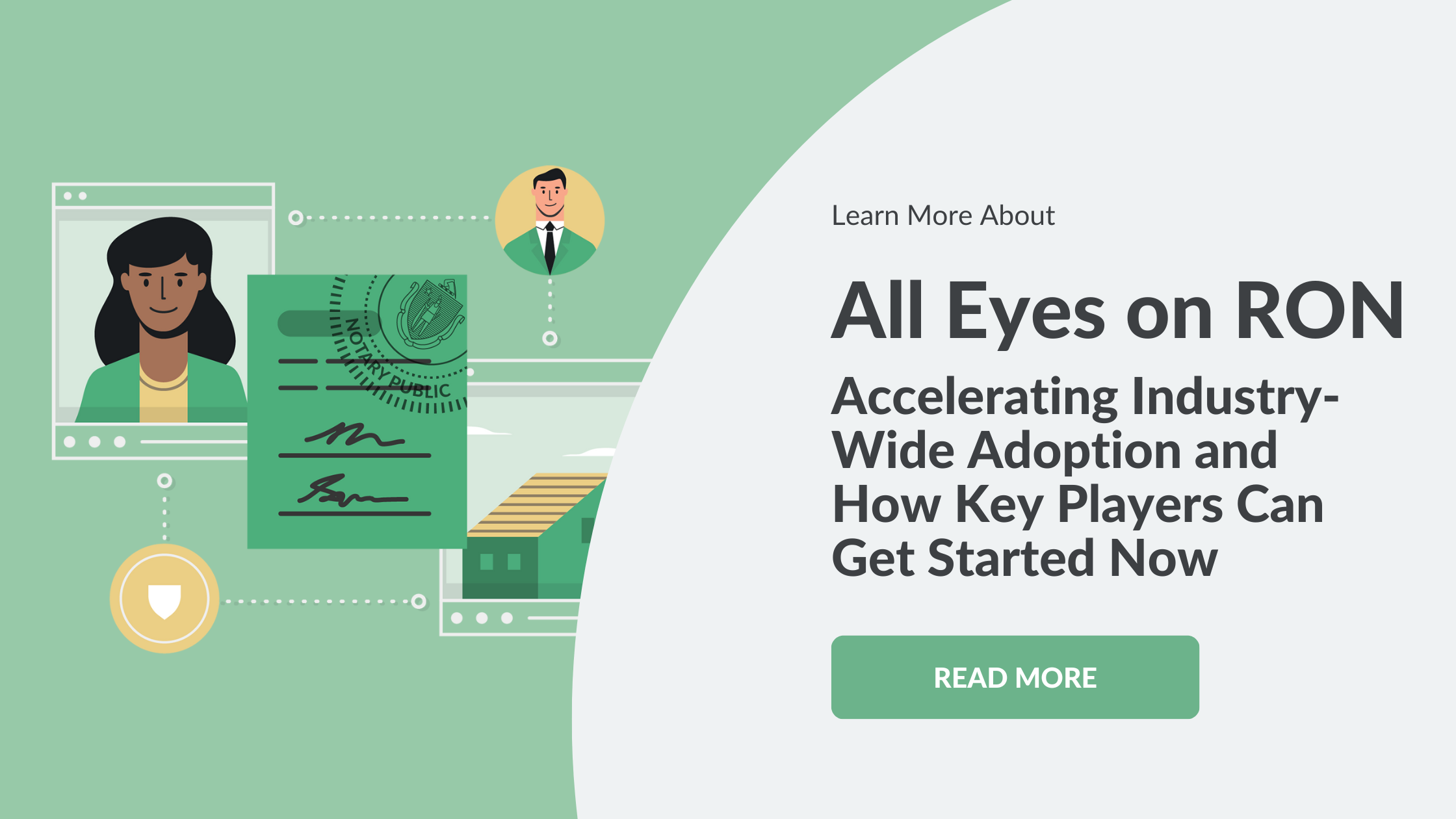This post is part 2 of a multi-part educational series on remote online notarization. For part 1 “What is Remote Online Notarization (RON)?” click here.
Remote online notarization (RON) eClosings require a unique set of documents, unlike a traditional closing package. Understanding these eClosing documents and their storage can initially sound like a maze of new terms and complicated technology; however, the components are actually quite simple and mirror that of a physical file transaction.
What documents are included in a RON eClosing?
A RON eClosing package comprises 4 key document sets:
- The eNote. An eNote is a special document specific to a RON eClosing (details on this in the next section).
- Electronically notarized documents. These are documents such as deeds, various affidavits, and power of attorney documents. These documents are eSigned using a RON platform that allows the notary to witness the signing over video and comply with other requirements outlined in the state’s legislation and guidelines. Visit our guide to becoming a remote online notary for more information on a career as a notary.
- eSigned lender documents. These are any additional documents from the lender that do not require notarization. These documents are electronically signed using an eSigning platform or eSigning feature built directly into the closing agent’s workflow software.
- eSigned title documents. These are any additional title-side documents that do not require notarization. Just like the lender-side documents, title documents are electronically signed using an eSigning platform or eSigning feature built directly into the closing agent’s workflow software.
What is an eNote?
An eNote is a digital version of a promissory note. In a mortgage transaction, the promissory note binds the borrower to the repayment of the loan. When mortgages are resold on the secondary mortgage market, the promissory note is transferred to the new investor. This piece of paper is one of the most important documents for an investor because the possession of the document allows them to enforce the debt obligation.
However, the challenge with digital promissory notes is that electronic files such as digital PDFs can easily be copied. To address this issue, mortgage lenders use a special file format to generate an eNote. This format ensures a single, authoritative copy of the eNote. The format is called a MISMO XML SMARTDoc eNote. eSignatures on an eNote are applied in real-time and wrapped with a tamper-evident seal.
How are eNotes stored and transferred? The eVault & eRegistry
In addition to the creation of eNotes, the industry devised an infrastructure to transfer and maintain eNotes.
- An eRegistry called the Mortgage Electronic Registration System (MERS) allows the eNote to be tracked and recorded as it moves from investor to investor.
- An eVault that acts as a data warehouse. Each eVault is registered with MERS.
Once the eNote is executed, it is stored in an eVault. At the same time, it is registered with MERS and a controller and location are assigned. As the eNote moves on the secondary market, the MERS registry is updated with all transfers of control and location captured.
eNote registration with MERS also enables the mortgage lending industry to interpret the adoption of eMortgages through registration data. According to MERS data presented during a recent HousingWire webinar, eNote registration exploded in growth between 2018 and 2019 and continued to set new records in 2020.
- Total eNote registration in 2018: 16,950
- Total eNote registration in 2019: 127,358
- Total eNote registration in 2020: 462,671
Historically, mortgage lenders have been slow to adopt eNotes due to the challenges associated with selling RON transactions to aggregators, government-sponsored enterprises (GSEs), and elsewhere in the secondary market. The acceleration of eNote adoption during COVID-19 may be due to modifications issued by GSEs to accept RON transactions. In March 2020, GSEs Fannie Mae and Freddie Mac announced modifications to single-family selling guides which include relaxed requirements for RON. Fannie Mae provided a list of more than 40 states where lenders may sell loans closed with RON.
How are RON Closing Documents Recorded? eRecording
After documents are eSigned and electronically notarized, the documents are digitally submitted and recorded with the county recording office using a process called eRecording. The eRecording system encrypts and securely transmits the documents to the recording office. Once received, the jurisdiction records the documents and returns them securely with the recording stamp.
The eRecording process is legal in all 50 states; however, some county recording offices do not have the technology infrastructure in place to accept eRecorded documents. During the coronavirus pandemic, many county recording offices accelerated their adoption of eRecording technology. According to The Property Records Industry Association (PRIA), over 2,400 counties now e-record, up from 2,100 counties in March 2020.
Learn how lenders, underwriters, and title & escrow businesses can get started with RON by downloading our eGuide, “All Eyes on RON: Accelerating Industry-Wide Adoption and How Key Players Can Get Started Now.”


